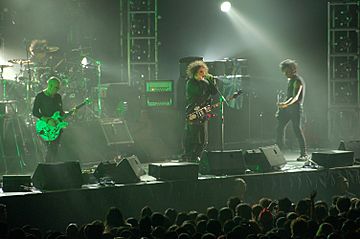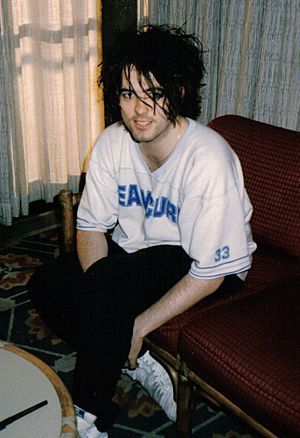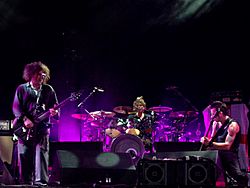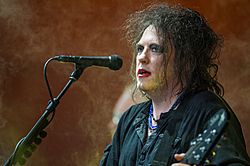The Cure facts for kids
Quick facts for kids
The Cure
|
|
|---|---|

The Cure performing in August 2007; from left to right: Porl Thompson, Jason Cooper, Robert Smith, and Simon Gallup
|
|
| Background information | |
| Origin | Crawley, West Sussex, England |
| Genres |
|
| Years active | 1978–present |
| Labels | |
| Associated acts |
|
| Members |
|
| Past members |
|
The Cure is a famous English rock band that started in 1978 in Crawley, West Sussex. Even though many band members have changed over the years, Robert Smith has always been there. He is the guitarist, lead singer, and songwriter.
The band's first album, Three Imaginary Boys (1979), and their early songs helped them become part of the post-punk and new wave music scenes in the UK. With their second album, Seventeen Seconds (1980), The Cure started playing a darker, more emotional style of music. This sound, along with Robert Smith's unique look, greatly influenced the new gothic rock genre and the Goth community.
After their fourth album in 1982, Smith added more pop sounds to their music. This helped them become very successful around the world. Their collection of singles, Standing on a Beach (1986), sold millions of copies. They reached their biggest success with the albums Disintegration (1989) and Wish (1992). The Cure has released 13 studio albums and over 30 singles. They have sold more than 30 million albums worldwide. Their most recent album, 4:13 Dream, came out in 2008. In 2019, The Cure was added to the Rock and Roll Hall of Fame.
Contents
The Cure's Journey: From School Friends to Rock Stars
How The Cure Started (1973–1979)
The first members of The Cure were friends from school in Crawley, West Sussex. They first played together in 1973 as a school band called Obelisk. In 1976, some of them formed a rock band called Malice. Robert Smith played guitar, and Michael Dempsey played bass.
Later, in 1977, the band changed its name to Easy Cure. They won a talent show and signed a record deal with a German company. After their singer left, Robert Smith became the lead vocalist. In 1978, Easy Cure's contract ended. The band decided to remove guitarist Porl Thompson because his style didn't fit Smith's new, simpler songwriting ideas. Smith then renamed the remaining three members "The Cure."
The Cure recorded a demo tape that was heard by Chris Parry, who signed them to his new Fiction label. Their first single, "Killing an Arab", came out in December 1978. The song caused some talk because of its title, but it was actually based on a book called The Stranger. The band put a sticker on later versions of the single to explain it wasn't racist.
In May 1979, The Cure released their first album, Three Imaginary Boys. Robert Smith wasn't completely happy with it, feeling it was too "lightweight." Their second single, "Boys Don't Cry", was released in June. The Cure then toured as a support band for Siouxsie and the Banshees. Smith even played guitar for the Banshees when their guitarist left. This experience greatly influenced him and changed his ideas about music.
After their third single, "Jumping Someone Else's Train", bassist Michael Dempsey left the band. Simon Gallup (bass) and Matthieu Hartley (keyboards) joined The Cure. This new lineup started playing songs for their next album.
Exploring Darker Sounds (1980–1982)
Robert Smith had more control over the recording of The Cure's second album, Seventeen Seconds, released in 1980. It reached number 20 on the UK charts. The song "A Forest" became their first UK hit single. This album was different from their first, with a more serious and atmospheric sound.
In 1981, they released their third album, Faith, which continued the serious mood. It reached number 14 in the UK. By this time, the band's music was very intense, and sometimes Smith would even cry after performing.
In 1982, The Cure released their fourth album. After this, they started their "Fourteen Explicit Moments" tour. During this tour, they began to use their famous look: big hair and smeared lipstick. After the tour, Simon Gallup left the band. Smith then rejoined Siouxsie and the Banshees as their lead guitarist for a while.
Finding Mainstream Success (1983–1988)
With Gallup gone and Smith working with other bands, some thought The Cure might break up. But their manager, Chris Parry, wanted The Cure to try a new musical style. Smith and Lol Tolhurst (who now played keyboards instead of drums) agreed. They released the single "Let's Go to Bed" in late 1982. Even though Smith thought it was a simple pop song, it became a small hit in the UK and a bigger hit in Australia and New Zealand.
In 1983, they had more successful songs: "The Walk" and "The Love Cats". "The Love Cats" was their first song to reach the Top 10 in the UK. These songs were put together on the Japanese Whispers album.
In 1984, The Cure released The Top, which had a psychedelic sound. Smith played most of the instruments on this album. It was a Top 10 hit in the UK and their first album to appear on the Billboard 200 chart in the US. The Cure then toured worldwide. During this tour, drummer Andy Anderson was replaced by Boris Williams. Bassist Phil Thornalley also left. Soon after, Simon Gallup rejoined the band, and Smith was very happy about it.
In 1985, the new lineup (Smith, Tolhurst, Gallup, Thompson, and Williams) released The Head on the Door. This album combined the band's happy and sad music styles. It reached number seven in the UK and was their first album to enter the US Top 75. This success was partly due to the popular singles "In Between Days" and "Close to Me".
In 1986, they released a collection of singles called Standing on a Beach. This album reached the US Top 50. They also released a video collection called Staring at the Sea and a live concert video called The Cure in Orange. The band became very popular in Europe and increasingly popular in the US and Canada.
In 1987, The Cure released the double album Kiss Me, Kiss Me, Kiss Me. It reached number six in the UK and was their first album to enter the US Top 40, becoming platinum (selling over a million copies). The song "Just Like Heaven" was their most successful single in the US at that time. After the album, Roger O'Donnell joined as a keyboard player, and the band toured as a six-member group.
Worldwide Stardom and Disintegration (1989–1993)
In 1989, The Cure released Disintegration. Critics loved it, and it became their highest-charting album, reaching number three in the UK. It had three Top 30 singles: "Lullaby", "Lovesong", and "Pictures of You". Disintegration also reached number twelve in the US. The song "Lovesong" became their only single to reach the US Top 10. By 1992, Disintegration had sold over three million copies worldwide.
During the making of Disintegration, the band members told Smith that Lol Tolhurst had to leave. In February 1989, Tolhurst officially left the band. Roger O'Donnell became a full member, making Smith the only original founding member left. The Cure then went on a very successful tour, playing in large stadiums in the US.
In May 1990, O'Donnell left, and Perry Bamonte joined as a guitar technician. In November, The Cure released Mixed Up, a collection of remixes. In 1991, The Cure won a Brit Award for Best British Group.
The band then recorded their next album, Wish (1992). It reached number one in the UK and number two in the US. It included the international hits "High" and "Friday I'm in Love". Wish was also nominated for a Grammy Award for Best Alternative Music Album in 1993. Later in 1993, the band released two live albums, Show and Paris, from their Wish tour.
After the Wish tour, the band's lineup changed again. Porl Thompson left, and Perry Bamonte became the lead guitarist. Roger O'Donnell returned to play keyboards. Boris Williams also left and was replaced by Jason Cooper on drums.
New Music and Changes (1994–2005)
In 1994, The Cure wrote the song "Burn" for the movie The Crow. The movie's soundtrack reached number one on the Billboard 200 charts.
The band started working on a new album in 1994. Wild Mood Swings was released in 1996. It wasn't as popular as their earlier albums and marked the end of their biggest commercial success. In 1997, the band released Galore, a collection of their singles from 1987 to 1997. It also included a new song, "Wrong Number".
In 1998, The Cure contributed a song to The X-Files movie soundtrack and covered a Depeche Mode song for a tribute album.
With only one album left on their record deal, Robert Smith thought The Cure might be ending. He wanted to make a more serious album. The album Bloodflowers was released in 2000 and was nominated for a Grammy Award. The band then went on the nine-month Dream Tour. In 2001, The Cure left Fiction Records and released their Greatest Hits album and DVD. In 2002, they released The Cure: Trilogy, a live concert video recorded in Berlin.
In 2003, The Cure signed with Geffen Records. In 2004, they released a four-disc box set called Join the Dots: B-Sides & Rarities, 1978–2001. Their twelfth album, The Cure, was released in 2004 and quickly became a top ten album in both the US and UK. To promote the album, they played at the Coachella Valley Music and Arts Festival. They also headlined the Curiosa tour in North America, which was a traveling festival with other bands like Interpol and Muse. In 2004, the band received an MTV Icon award.
In May 2005, Roger O'Donnell and Perry Bamonte left the band. Robert Smith said he wanted to reduce the band to a three-piece. The remaining members (Smith, Gallup, and Cooper) played as a trio before Porl Thompson returned for their summer 2005 tour. In July 2005, the band performed at the Live 8 benefit concert in Paris.
Recent Years and Anniversaries (2006–Present)
The Cure started working on their thirteenth album in 2006. They released four singles and an EP in the months leading up to the album's release. The album, 4:13 Dream, came out in October 2008. In February 2009, The Cure received the "Godlike Genius" award from NME magazine.
Roger O'Donnell officially rejoined The Cure in 2011. The band then started their "Reflections" concert series, where they played their first three albums in full. They performed these concerts in London, New York City, and Los Angeles. In 2012, The Cure was nominated for induction into the Rock and Roll Hall of Fame.
In March 2012, The Cure announced they would headline several summer music festivals in Europe. In May, Porl Thompson (now known as Pearl Thompson) announced he had left the band. Reeves Gabrels joined as a guitarist for their tour and later became a full member. In 2013, The Cure toured South America for the first time since 1987.
In 2014, The Cure covered the Beatles' song "Hello, Goodbye" for an album honoring Paul McCartney. Paul's son, James McCartney, sang and played keyboards on the song.
In June 2018, The Cure headlined the 25th annual Meltdown Festival in London. Robert Smith also helped choose the other artists for the festival. On July 7, 2018, The Cure played a 40th-anniversary concert in Hyde Park. For Record Store Day 2018, they released a remastered version of Mixed Up and a new album of remixes called Torn Down, all created by Robert Smith.
In 2019, The Cure went on a 23-date summer tour, mostly playing at festivals. They also performed four shows in Sydney, Australia, with the final show streamed live. Later that year, they released a box set called 40 Live: CURÆTION-25 + Anniversary, featuring their Meltdown and Hyde Park performances.
In 2021, Robert Smith mentioned that the band had recorded two new albums. He described one as "very, very doom and gloom" and the other as different. In August 2021, bassist Simon Gallup posted on social media that he had left the band, but later confirmed he was still a member.
In March 2022, Smith confirmed the first new album would be called Songs of a Lost World. Perry Bamonte returned to the band's lineup for their Lost World Tour, which began in October 2022.
The Cure's Music Style
The Cure is often linked to the gothic rock genre, and many see them as a key band in this style. However, the band itself often says they don't fit into just one category. Robert Smith said in 2006, "We're not categorisable. I just play Cure music, whatever that is." While they are known for dark and serious music, The Cure has also made many upbeat songs and were part of the new wave movement.
The Cure's music often features strong, catchy bass lines, Smith's unique vocals, and lyrics that explore deep, sometimes sad, feelings. Many of their songs start with Smith and Gallup creating the drum and bass parts. Keyboards have been important to their sound since Seventeen Seconds, and they became even more important on Disintegration.
Music Videos
The band's early music videos were not very good, and the band members themselves didn't like them. But then they started working with director Tim Pope for the video "Let's Go to Bed." Pope added a fun and playful side to their videos.
Tim Pope directed most of The Cure's videos, which became very well-known and helped the band reach more fans in the 1980s. Pope enjoyed working with The Cure because Robert Smith understood how to act for the camera. He said Smith's songs were "cinematic" and had both humor and deep emotions.
The Cure's Impact and Awards
The Cure was one of the first alternative bands to have chart success before alternative rock became popular. In 1992, NME magazine called The Cure "the most successful alternative band that ever shuffled disconsolately about the earth." Robert Smith was even featured on the cover of NME magazine's "Originals: Goth" edition in 2004, showing his importance in gothic rock.
Many other bands have been influenced by The Cure. For example, the lead singer of Interpol, Paul Banks, said The Cure influenced all of them, especially their bassist. The Smashing Pumpkins also named The Cure as a major influence.
The Rock and Roll Hall of Fame inducted The Cure in 2019. This is a huge honor for bands. The members inducted were Perry Bamonte, Jason Cooper, Michael Dempsey, Reeves Gabrels, Simon Gallup, Roger O'Donnell, Robert Smith, Porl Thompson, Lol Tolhurst, and Boris Williams. Trent Reznor inducted them at the ceremony, and The Cure performed five songs.
The Cure has sold over 30 million albums worldwide, showing their lasting popularity.
Awards and Recognitions
The Cure has received many awards for their music. They have won two Brit Awards: one for Best British Video for "Lullaby" in 1990, and another for Best British Group in 1991. They also won an MTV Video Music Award for "Friday I'm In Love" in 1992.
Robert Smith has also received special honors. He was given an Ivor Novello Award for International Achievement in 2001. In 2022, Robert Smith and Simon Gallup received the Music Icon Award from the Ivor Novello Awards. The Cure also won the "Godlike Genius Award" from NME magazine in 2009 and "Best Festival Headliner" in 2020.
Discography
- Three Imaginary Boys (1979)
- Seventeen Seconds (1980)
- Faith (1981)
- The Top (1984)
- The Head on the Door (1985)
- Kiss Me, Kiss Me, Kiss Me (1987)
- Disintegration (1989)
- Wish (1992)
- Wild Mood Swings (1996)
- Bloodflowers (2000)
- The Cure (2004)
- 4:13 Dream (2008)
Band members
- Robert Smith – lead vocals, guitars, six-string bass guitar, keyboards (1978–present)
- Simon Gallup – bass guitar, keyboards (1979–1982, 1984–present)
- Roger O'Donnell – keyboards (1987–1990, 1995–2005, 2011–present)
- Perry Bamonte – guitars, six-string bass guitar, keyboards (1990–2005, 2022–present)
- Jason Cooper – drums (1995–present)
- Reeves Gabrels – guitars, six-string bass guitar (2012–present)
See also
 In Spanish: The Cure para niños
In Spanish: The Cure para niños




